Inbox and Environment News: Issue 373
August 26 - September 1, 2018: Issue 373
Winter Becomes Spring In Pittwater
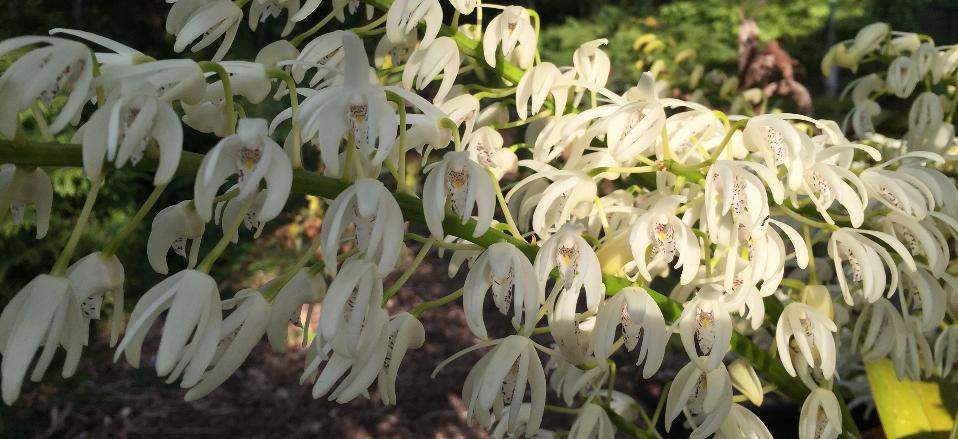
Rock Orchid now in bloom, as spring is near. It grows on rocks or sides of trees, so it tolerates this dry weather . It has had a name change from Dendrobium speciosum.
For more details and meaning of its names see: www.anbg.gov.au/gnp/interns-2003/thelychiton-speciosum.html
Information and Photo courtesy Pittwater Natural Heritage Association

Rock Orchid now in bloom, as spring is near. It grows on rocks or sides of trees, so it tolerates this dry weather . It has had a name change from Dendrobium speciosum.
For more details and meaning of its names see: www.anbg.gov.au/gnp/interns-2003/thelychiton-speciosum.html
Information and Photo courtesy Pittwater Natural Heritage Association
Katandra Season 2018: Bring On The Flowers Post The Hazard Reduction!
More good news is that Katandra Bushland Sanctuary is open again on Sundays in Spring, after the hazard reduction burn around the Yurt, just visible at top. We are taking photos to record the regeneration. Just need some rain to get this going........
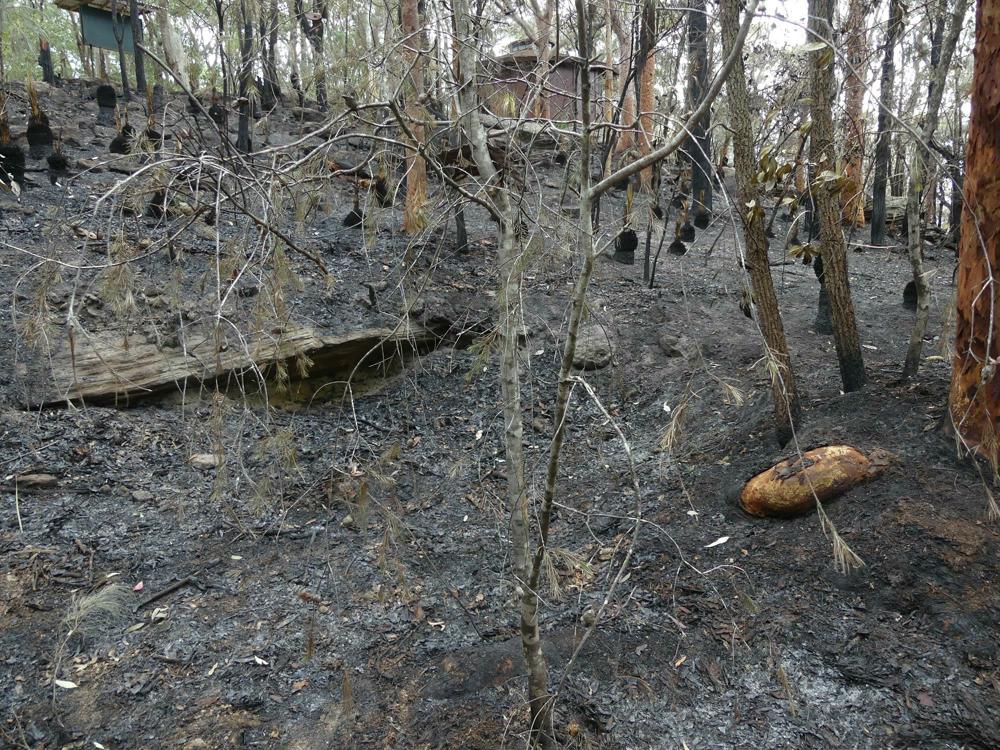
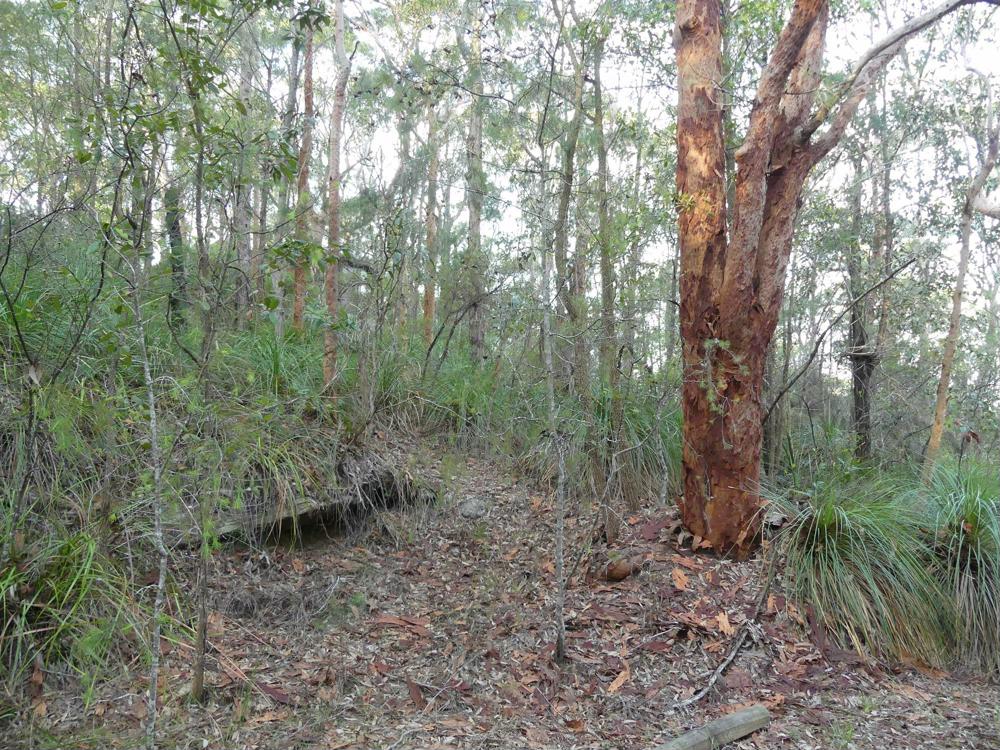
Before the burn, seen from main track
Information and Photo courtesy Pittwater Natural Heritage Association - Visit Katandra's Profile for more details
More good news is that Katandra Bushland Sanctuary is open again on Sundays in Spring, after the hazard reduction burn around the Yurt, just visible at top. We are taking photos to record the regeneration. Just need some rain to get this going........


Before the burn, seen from main track
Information and Photo courtesy Pittwater Natural Heritage Association - Visit Katandra's Profile for more details
New Study Highlights Shark Protections, Vulnerability To Fishing
August 23, 2018
A new analysis shows that the habitats of three shark species (great hammerhead, tiger, and bull sharks) are relatively well protected from longline fishing in federal waters off the southeastern United States, but that that some prime locations are still vulnerable to fishing.
The new study led by scientists at the University of Miami (UM) Rosenstiel School of Marine and Atmospheric Science has important implications to further protect these at-risk species from unintentional fishing, known as bycatch, in U.S. federal waters.
Great hammerhead sharks are considered overfished and are experiencing population declines in the subtropical Atlantic Ocean and Gulf of Mexico. Tiger and bull shark populations have experienced declines to a lesser extent in the region over the past several decades and their populations appear to be stabilizing at present.
The research team analyzed data from 96 tagged great hammerheads, tiger, and bull sharks to create habitat suitability models that reveal specific areas where these sharks are most likely to occur due to favorable environmental conditions. These 'highly suitable habitats' were then compared to areas where longline fishing gear is currently prohibited to determine what proportion of their habitats are protected from, and vulnerable to, longline fishing activity.
The analysis showed that highly suitable habitats overlapping with the longline fishing restricted areas varied by species and season. Highly suitable habitats of great hammerheads and tiger sharks were relatively well protected from pelagic longlines yet vulnerable to bottom longline fishing. In addition, both species were vulnerable to pelagic and bottom longline fishing off southwestern Florida. Accordingly, the researchers suggested that extending longline gear restrictions to this area may benefit both great hammerhead and tiger sharks species.
"This study highlights the importance of considering seasonal trends in habitat use and movement patterns as these can vary greatly throughout the year and may impact the effectiveness of management plans for these species," said the study's lead author Hannah Calich, a UM Rosenstiel School alumna and current Ph.D. student at the University of Western Australia.
"Given the wide ranging movements of many migratory marine animals, the extent to which management areas protect their key habitats is often unknown and certainly very challenging to determine," said Neil Hammerschlag, a Research Associate Professor at UM's Rosenstiel School and study co-author. "We hope our approach will be helpful to researchers working with other migratory species, such as billfish, turtles, whales, seals, and tunas, to better help address these conservation issues."
The study, titled "Overlap between habitat suitability and longline gear management areas reveals vulnerable and protected habitats for highly migratory sharks," was published on Aug. 23 in the journal Marine Ecology Progress Series.
The study's authors include: Hannah Calich, Maria Estevanez and Neil Hammerschlag from the UM Rosenstiel School of Marine and Atmospheric Science.
The research was supported by The Batchelor Foundation, Disney Conservation Fund, Wells Fargo, Guy Harvey Ocean Foundation, and the West Coast Inland Navigation District.
H Calich, M Estevanez, N Hammerschlag. Overlap between highly suitable habitats and longline gear management areas reveals vulnerable and protected regions for highly migratory sharks. Marine Ecology Progress Series, 2018; 602: 183 DOI: 10.3354/meps12671
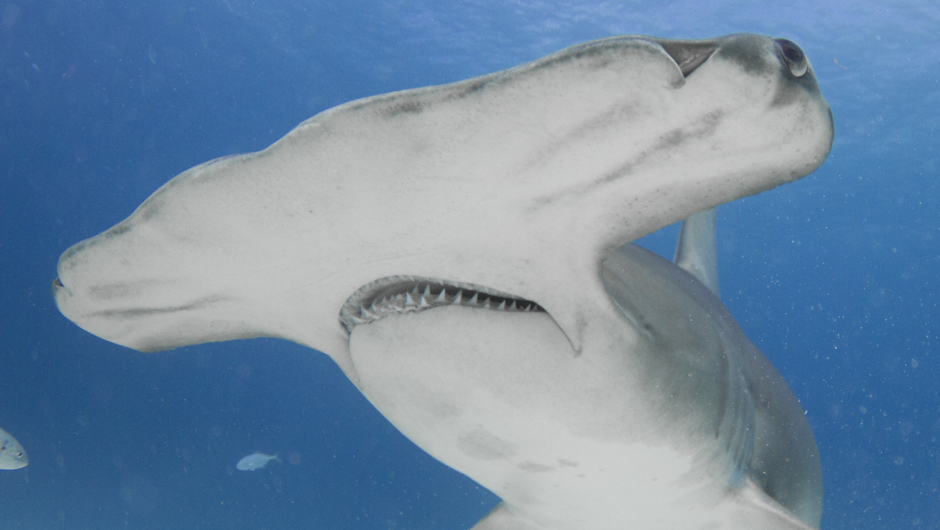
Great hammerhead sharks are considered overfished and are experiencing population declines in the subtropical Atlantic Ocean and Gulf of Mexico. Credit: Neil Hammerschlag, Ph.D., University of Miami Rosenstiel School of Marine and Atmospheric Science
August 23, 2018
A new analysis shows that the habitats of three shark species (great hammerhead, tiger, and bull sharks) are relatively well protected from longline fishing in federal waters off the southeastern United States, but that that some prime locations are still vulnerable to fishing.
The new study led by scientists at the University of Miami (UM) Rosenstiel School of Marine and Atmospheric Science has important implications to further protect these at-risk species from unintentional fishing, known as bycatch, in U.S. federal waters.
Great hammerhead sharks are considered overfished and are experiencing population declines in the subtropical Atlantic Ocean and Gulf of Mexico. Tiger and bull shark populations have experienced declines to a lesser extent in the region over the past several decades and their populations appear to be stabilizing at present.
The research team analyzed data from 96 tagged great hammerheads, tiger, and bull sharks to create habitat suitability models that reveal specific areas where these sharks are most likely to occur due to favorable environmental conditions. These 'highly suitable habitats' were then compared to areas where longline fishing gear is currently prohibited to determine what proportion of their habitats are protected from, and vulnerable to, longline fishing activity.
The analysis showed that highly suitable habitats overlapping with the longline fishing restricted areas varied by species and season. Highly suitable habitats of great hammerheads and tiger sharks were relatively well protected from pelagic longlines yet vulnerable to bottom longline fishing. In addition, both species were vulnerable to pelagic and bottom longline fishing off southwestern Florida. Accordingly, the researchers suggested that extending longline gear restrictions to this area may benefit both great hammerhead and tiger sharks species.
"This study highlights the importance of considering seasonal trends in habitat use and movement patterns as these can vary greatly throughout the year and may impact the effectiveness of management plans for these species," said the study's lead author Hannah Calich, a UM Rosenstiel School alumna and current Ph.D. student at the University of Western Australia.
"Given the wide ranging movements of many migratory marine animals, the extent to which management areas protect their key habitats is often unknown and certainly very challenging to determine," said Neil Hammerschlag, a Research Associate Professor at UM's Rosenstiel School and study co-author. "We hope our approach will be helpful to researchers working with other migratory species, such as billfish, turtles, whales, seals, and tunas, to better help address these conservation issues."
The study, titled "Overlap between habitat suitability and longline gear management areas reveals vulnerable and protected habitats for highly migratory sharks," was published on Aug. 23 in the journal Marine Ecology Progress Series.
The study's authors include: Hannah Calich, Maria Estevanez and Neil Hammerschlag from the UM Rosenstiel School of Marine and Atmospheric Science.
The research was supported by The Batchelor Foundation, Disney Conservation Fund, Wells Fargo, Guy Harvey Ocean Foundation, and the West Coast Inland Navigation District.
H Calich, M Estevanez, N Hammerschlag. Overlap between highly suitable habitats and longline gear management areas reveals vulnerable and protected regions for highly migratory sharks. Marine Ecology Progress Series, 2018; 602: 183 DOI: 10.3354/meps12671

Great hammerhead sharks are considered overfished and are experiencing population declines in the subtropical Atlantic Ocean and Gulf of Mexico. Credit: Neil Hammerschlag, Ph.D., University of Miami Rosenstiel School of Marine and Atmospheric Science
Bird Feared Extinct Rediscovered In The Bahamas
August 23, 2018: University of East Anglia
One of the rarest birds in the western hemisphere, the Bahama Nuthatch, has been rediscovered by research teams searching the island of Grand Bahama.
The finding is particularly significant because the species had been feared extinct following the catastrophic damage caused by Hurricane Matthew in 2016, and had not been found in subsequent searches.
But it is feared that there could only be two left -- placing the species on the verge of extinction and certainly among the world's most critically endangered birds.
The Bahama Nuthatch is an endangered species, only known from a small area of native pine forest on Grand Bahama Island, which lies approximately 100 miles off Palm Beach, Florida.
University of East Anglia masters students Matthew Gardner and David Pereira set out on a three-month expedition to find this and other endemic Caribbean pine forest bird species.
They made their way through dense forest with thick 'poisonwood' understorey -- the layer of vegetation growing beneath the main forest canopy -- in what is thought to be one of the most exhaustive searches of the island.
They worked in partnership with Nigel Collar and David Wege from Birdlife International and the Bahamas National Trust, the organisation which works to protect the habitats and species of The Bahama Islands.
Meanwhile a second team of Bahamian students, led by Zeko McKenzie of the University of The Bahamas-North and supported by the American Bird Conservancy, also searched for the bird.
The Bahama Nuthatch has a long bill, a distinctive high-pitched squeaky call, and nests only in mature pine trees. There had been a sharp decline in its population crashing from an estimated 1,800 in 2004 to just 23 being seen in a survey in 2007. The decline likely began in the 1950s due to habitat loss due to timber removal, and more recently due to hurricane damage, storm surges having killed large areas native forest.
Both teams made Nuthatch sightings in May, and the UEA team were lucky enough to capture the elusive bird on film.
Dr Diana Bell, from UEA's School of Biological Sciences, said: "The Bahama Nuthatch is a critically endangered species, threatened by habitat destruction and degradation, invasive species, tourist developments, fires and hurricane damage.
"Our researchers looked for the bird across 464 survey points in 34,000 hectares of pine forest. It must have been like looking for a needle in a hay stack. They played out a recording of the bird's distinctive call in order to attract it.
"As well as searching for the elusive bird, they also collected environmental data to better understand its habitat preferences and surveyed the extent of hurricane and fire damage," she added."
Matthew Gardner said: "We were the first to undertake such an exhaustive search through 700km of forest on foot.
"We had been scouring the forest for about six weeks, and had almost lost hope. At that point we'd walked about 400km. Then, I suddenly heard its distinctive call and saw the unmistakable shape of a Nuthatch descending towards me. I shouted with joy, I was ecstatic!"
The UEA team made six Nuthatch sightings in total, and McKenzie's team independently made five sightings, using different methods, in the same small area of forest -- including a sighting of what they believe to be two birds together.
Mr Gardner said: "During three months of intensive searching we made six Bahama Nuthatch sightings. Our search was extremely thorough but we never saw two birds together, so we had thought there might only be one left in existence."
"The other team have reported seeing two together so that is promising. However, these findings place the species on the verge of extinction and certainly amongst the world's most critically endangered birds."
"We also don't know the sex of the birds. In many cases when birds dwindle to such small numbers, any remaining birds are usually male."
"The photographs clearly show this distinctive species and cannot be anything else" said Michael Parr, President of American Bird Conservancy and a UEA alumnus.
"Fortunately this is not a hard bird to identify, but it was certainly a hard bird to find," he added.
The Nuthatch was spotted in a small area known as Lucaya Estates. During the research project, birds were seen and heard in three distinct but nearby locations within this area.
Researcher Zeko McKenzie said: "Although the Bahama Nuthatch has declined precipitously, we are encouraged by the engagement of conservation scientists who are now looking for ways to save and recover the species."
The UEA team however are less optimistic as the exact drivers of the precipitous decline of the bird are still unclear.
Dr Diana Bell said: "Sadly, we think that the chances of bringing this bird back from the brink of extinction are very slim -- due to the very low numbers left, and because we are not sure of the precise drivers for its decline.
"But it is still absolutely crucial that conservation efforts in the native Caribbean pine forest do not lapse as it is such an important habitat for other endemic birds including the Bahama Swallow, Bahama Warbler and Bahama Yellowthroat.
"The habitat is also incredibly important for North American migrants including the Kirtlands Warbler," she added.
Ellsworth Weir, Grand Bahama Parks Manager at the Bahamas National Trust, said: "It has been a pleasure for The Bahamas National Trust to host both Matthew and David as they conducted this very important research on Grand Bahama."
"Their work has taken them across the length and breadth of the island in what was likely the most in depth search to be conducted. Their research, which was inclusive of bird and habitat surveys, has helped to answer questions that some residents have been asking for some time."
"Sadly, we realize now that we are faced with a very dire situation regarding the Bahama Nuthatch. We wouldn't have realized the extent of the issue without the persistent efforts of David and Matthew."
A short video is available here: https://youtu.be/0eiy6yWxeqA
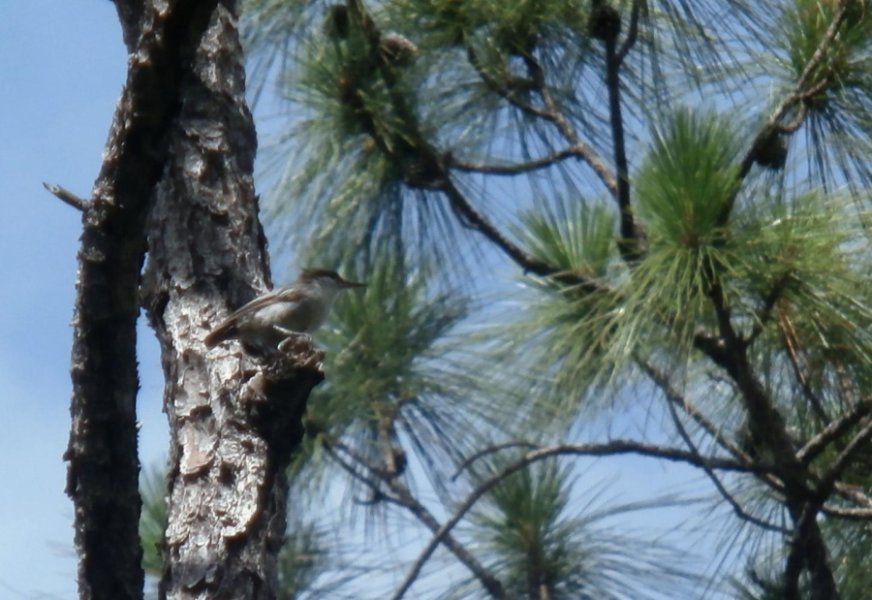
One of the rarest birds in the western hemisphere, the Bahama Nuthatch, has been rediscovered by research teams searching the island of Grand Bahama. The finding is particularly significant because the species had been feared extinct following the catastrophic damage caused by Hurricane Matthew in 2016, and had not been found in subsequent searches. But it is feared that there could only be two left -- placing the species on the verge of extinction and certainly among the world's most critically endangered birds. Credit: Matthew Gardner, University of East Anglia
August 23, 2018: University of East Anglia
One of the rarest birds in the western hemisphere, the Bahama Nuthatch, has been rediscovered by research teams searching the island of Grand Bahama.
The finding is particularly significant because the species had been feared extinct following the catastrophic damage caused by Hurricane Matthew in 2016, and had not been found in subsequent searches.
But it is feared that there could only be two left -- placing the species on the verge of extinction and certainly among the world's most critically endangered birds.
The Bahama Nuthatch is an endangered species, only known from a small area of native pine forest on Grand Bahama Island, which lies approximately 100 miles off Palm Beach, Florida.
University of East Anglia masters students Matthew Gardner and David Pereira set out on a three-month expedition to find this and other endemic Caribbean pine forest bird species.
They made their way through dense forest with thick 'poisonwood' understorey -- the layer of vegetation growing beneath the main forest canopy -- in what is thought to be one of the most exhaustive searches of the island.
They worked in partnership with Nigel Collar and David Wege from Birdlife International and the Bahamas National Trust, the organisation which works to protect the habitats and species of The Bahama Islands.
Meanwhile a second team of Bahamian students, led by Zeko McKenzie of the University of The Bahamas-North and supported by the American Bird Conservancy, also searched for the bird.
The Bahama Nuthatch has a long bill, a distinctive high-pitched squeaky call, and nests only in mature pine trees. There had been a sharp decline in its population crashing from an estimated 1,800 in 2004 to just 23 being seen in a survey in 2007. The decline likely began in the 1950s due to habitat loss due to timber removal, and more recently due to hurricane damage, storm surges having killed large areas native forest.
Both teams made Nuthatch sightings in May, and the UEA team were lucky enough to capture the elusive bird on film.
Dr Diana Bell, from UEA's School of Biological Sciences, said: "The Bahama Nuthatch is a critically endangered species, threatened by habitat destruction and degradation, invasive species, tourist developments, fires and hurricane damage.
"Our researchers looked for the bird across 464 survey points in 34,000 hectares of pine forest. It must have been like looking for a needle in a hay stack. They played out a recording of the bird's distinctive call in order to attract it.
"As well as searching for the elusive bird, they also collected environmental data to better understand its habitat preferences and surveyed the extent of hurricane and fire damage," she added."
Matthew Gardner said: "We were the first to undertake such an exhaustive search through 700km of forest on foot.
"We had been scouring the forest for about six weeks, and had almost lost hope. At that point we'd walked about 400km. Then, I suddenly heard its distinctive call and saw the unmistakable shape of a Nuthatch descending towards me. I shouted with joy, I was ecstatic!"
The UEA team made six Nuthatch sightings in total, and McKenzie's team independently made five sightings, using different methods, in the same small area of forest -- including a sighting of what they believe to be two birds together.
Mr Gardner said: "During three months of intensive searching we made six Bahama Nuthatch sightings. Our search was extremely thorough but we never saw two birds together, so we had thought there might only be one left in existence."
"The other team have reported seeing two together so that is promising. However, these findings place the species on the verge of extinction and certainly amongst the world's most critically endangered birds."
"We also don't know the sex of the birds. In many cases when birds dwindle to such small numbers, any remaining birds are usually male."
"The photographs clearly show this distinctive species and cannot be anything else" said Michael Parr, President of American Bird Conservancy and a UEA alumnus.
"Fortunately this is not a hard bird to identify, but it was certainly a hard bird to find," he added.
The Nuthatch was spotted in a small area known as Lucaya Estates. During the research project, birds were seen and heard in three distinct but nearby locations within this area.
Researcher Zeko McKenzie said: "Although the Bahama Nuthatch has declined precipitously, we are encouraged by the engagement of conservation scientists who are now looking for ways to save and recover the species."
The UEA team however are less optimistic as the exact drivers of the precipitous decline of the bird are still unclear.
Dr Diana Bell said: "Sadly, we think that the chances of bringing this bird back from the brink of extinction are very slim -- due to the very low numbers left, and because we are not sure of the precise drivers for its decline.
"But it is still absolutely crucial that conservation efforts in the native Caribbean pine forest do not lapse as it is such an important habitat for other endemic birds including the Bahama Swallow, Bahama Warbler and Bahama Yellowthroat.
"The habitat is also incredibly important for North American migrants including the Kirtlands Warbler," she added.
Ellsworth Weir, Grand Bahama Parks Manager at the Bahamas National Trust, said: "It has been a pleasure for The Bahamas National Trust to host both Matthew and David as they conducted this very important research on Grand Bahama."
"Their work has taken them across the length and breadth of the island in what was likely the most in depth search to be conducted. Their research, which was inclusive of bird and habitat surveys, has helped to answer questions that some residents have been asking for some time."
"Sadly, we realize now that we are faced with a very dire situation regarding the Bahama Nuthatch. We wouldn't have realized the extent of the issue without the persistent efforts of David and Matthew."
A short video is available here: https://youtu.be/0eiy6yWxeqA

One of the rarest birds in the western hemisphere, the Bahama Nuthatch, has been rediscovered by research teams searching the island of Grand Bahama. The finding is particularly significant because the species had been feared extinct following the catastrophic damage caused by Hurricane Matthew in 2016, and had not been found in subsequent searches. But it is feared that there could only be two left -- placing the species on the verge of extinction and certainly among the world's most critically endangered birds. Credit: Matthew Gardner, University of East Anglia
Friends Of Narrabeen Lagoon Catchment August 2018 Forum
 Next forum: Creeks in the Catchment7pm Monday August 27, 2018Coastal Environment Centre, Pelican Path,Lake Park Road, Narrabeen
Next forum: Creeks in the Catchment7pm Monday August 27, 2018Coastal Environment Centre, Pelican Path,Lake Park Road, Narrabeen
Presenters: Staff members from Northern Beaches Council will outline the works needed to control erosion and protect against flooding. Plus information about the bush regeneration projects in near creeks in the catchment.
Are you concerned about any of these issues?* Water quality in creeks leading to Narrabeen Lagoon* Health of aquatic wildlife* Creek flooding* Blockages in creeks* Erosion of creek banks* Rubbish in creeks* Weeds in riparian zones?Bring your concerns and questions to the forum on August 27 and find out more about creek care from Council staff.
Entry is free but we ask for a donation to cover expenses.Make sure you get a ticket preferably by emailing Judith Bennett email@narrabeenlagoon.org.au
 Next forum: Creeks in the Catchment
Next forum: Creeks in the CatchmentGetting Mobile In National Parks Easy With New Mobile App
August 22, 2018: NSW Office of Environment and Heritage
Over 28,000 people can't be wrong in thinking that the new NSW National Parks app makes visiting the State's most popular national parks and reserves much easier with information and maps ready to explore at your fingertips.
National Parks and Wildlife Service (NPWS) Director Visitor Experience, Julie Bishop said the beauty of many of our national parks is their remoteness and diverse landscapes but the very nature of these natural spaces means they are often outside current mobile networks.
“The new NSW National Parks app is already a hit with the state’s national parks visitors,” Ms Bishop said.
“Visitors can download maps and information on 225 of our parks before they go and have this information handy when they get there – even in areas with no reception, internet or Wi-Fi.
“This is one of the ways that the NSW Government is making information more digitally accessible for people wanting to get out and explore our national parks.
“The app utilises geolocation features so people can find parks and attractions close by as well as further afield, so they can better plan their trip while they’re on the go.
“Additional features include browsing and locating campgrounds, cabins and homesteads in the surrounding area – all at a glance.
“Users can also discover things to do and see, exploring nearby activities and attractions like a local.
“The app can also be used to check the attractions that have toilets, picnic areas and other facilities as well as information on accessibility,” Ms Bishop said.
Parks, activities and accommodation can also be saved as favourites, so users can quickly access their favourite things to do and see in national parks at the touch of a button.
The free NSW National Parks app is now available for download on iOS and Android.
For more information visit NSW National Parks app
August 22, 2018: NSW Office of Environment and Heritage
Over 28,000 people can't be wrong in thinking that the new NSW National Parks app makes visiting the State's most popular national parks and reserves much easier with information and maps ready to explore at your fingertips.
National Parks and Wildlife Service (NPWS) Director Visitor Experience, Julie Bishop said the beauty of many of our national parks is their remoteness and diverse landscapes but the very nature of these natural spaces means they are often outside current mobile networks.
“The new NSW National Parks app is already a hit with the state’s national parks visitors,” Ms Bishop said.
“Visitors can download maps and information on 225 of our parks before they go and have this information handy when they get there – even in areas with no reception, internet or Wi-Fi.
“This is one of the ways that the NSW Government is making information more digitally accessible for people wanting to get out and explore our national parks.
“The app utilises geolocation features so people can find parks and attractions close by as well as further afield, so they can better plan their trip while they’re on the go.
“Additional features include browsing and locating campgrounds, cabins and homesteads in the surrounding area – all at a glance.
“Users can also discover things to do and see, exploring nearby activities and attractions like a local.
“The app can also be used to check the attractions that have toilets, picnic areas and other facilities as well as information on accessibility,” Ms Bishop said.
Parks, activities and accommodation can also be saved as favourites, so users can quickly access their favourite things to do and see in national parks at the touch of a button.
The free NSW National Parks app is now available for download on iOS and Android.
For more information visit NSW National Parks app
New Chief Executive Officer Of The Australian Renewable Energy Agency
21 August 2018: Media release - The Hon. Josh Frydenberg MP, Minister for the Environment and Energy
The Turnbull Government is pleased to announce the appointment of Mr Darren Miller as the new Chief Executive Officer of the Australian Renewable Energy Agency (ARENA).
Mr Miller was co-founder and CEO of Mojo Power (an innovative electricity retailer) from 2015 until July 2018, Director of Asset Finance at Sungevity Australia in 2014 and founder and CEO of Sumwise (a technology and services company) from 2007 to 2013.
A Chartered Accountant with a Bachelor of Commerce (Hons), Mr Miller also previously held roles at New Zealand Natural and Ernst & Young.
“Mr Miller has 25 years of professional experience across a range of sectors including in chief executive positions and investment advisory roles,” Minister Frydenberg said.
“His experience in the renewable energy and electricity retail sectors as well as in start-up companies aligns well with ARENA’s development of local renewable energy technology.”
Having overseen 370 projects which have leveraged $2.8 billion dollars of investment, Mr Ivor Frischknecht advised the Government in February this year, he would not be seeking a third term as the CEO of ARENA.
“Mr Frischknecht has helped to make ARENA a success by utilising his expertise in energy, innovation and early stage investment,” Minister Frydenberg said.
“Under his guidance, ARENA has developed a clear set of priority investment areas consistent with the Turnbull Government’s emphasis on affordable and reliable energy.”
“I thank Mr Frischknecht for the significant contribution he has made in helping the Government to deliver a more affordable and reliable energy system and I look forward to working with Mr Miller over the coming years.”
Mr Miller will begin his three year term on 27 August 2018.
21 August 2018: Media release - The Hon. Josh Frydenberg MP, Minister for the Environment and Energy
The Turnbull Government is pleased to announce the appointment of Mr Darren Miller as the new Chief Executive Officer of the Australian Renewable Energy Agency (ARENA).
Mr Miller was co-founder and CEO of Mojo Power (an innovative electricity retailer) from 2015 until July 2018, Director of Asset Finance at Sungevity Australia in 2014 and founder and CEO of Sumwise (a technology and services company) from 2007 to 2013.
A Chartered Accountant with a Bachelor of Commerce (Hons), Mr Miller also previously held roles at New Zealand Natural and Ernst & Young.
“Mr Miller has 25 years of professional experience across a range of sectors including in chief executive positions and investment advisory roles,” Minister Frydenberg said.
“His experience in the renewable energy and electricity retail sectors as well as in start-up companies aligns well with ARENA’s development of local renewable energy technology.”
Having overseen 370 projects which have leveraged $2.8 billion dollars of investment, Mr Ivor Frischknecht advised the Government in February this year, he would not be seeking a third term as the CEO of ARENA.
“Mr Frischknecht has helped to make ARENA a success by utilising his expertise in energy, innovation and early stage investment,” Minister Frydenberg said.
“Under his guidance, ARENA has developed a clear set of priority investment areas consistent with the Turnbull Government’s emphasis on affordable and reliable energy.”
“I thank Mr Frischknecht for the significant contribution he has made in helping the Government to deliver a more affordable and reliable energy system and I look forward to working with Mr Miller over the coming years.”
Mr Miller will begin his three year term on 27 August 2018.
Entries Open For 2018 NSW Farmers Of The Year Award
July, 24, 2018: NSW DPINSW Minister for Primary Industries and outgoing NSW Farmers President Derek Schoen have announced applications for the prestigious NSW Farmer of the Year award have opened for 2018.
Speaking at the NSW Farmers Annual Conference today, Minister Blair said the award is both a celebration and recognition of farming excellence through the diverse range of enterprises across NSW.
“Our farmers represent some of the most innovative, industrious primary producers in the country and produce some of the highest quality food and fibre to be found anywhere in the world,” Minister Blair said.
“The state’s $15 billion primary industries sector is going from strength to strength under the stewardship of our farmers, who demonstrate drive and determination to run efficient, profitable and sustainable businesses.”
Mr Schoen has served as a judge of the award throughout his Presidency and said the 2017 finalists represented the breadth of NSW’s farming sector.
“From biodynamic, organic egg farming to a commercial cropping enterprise gaining efficiencies through environmental practices, from young guns through to farmers who have had a life-long commitment to farming excellence, the calibre of applications to the NSW Farmer of the Year award continues to be hugely impressive,” he said.
“The award helps identify outstanding farmers who are pushing the boundaries within their industry and in farming generally, and recognises people with outstanding management skills who demonstrate a combination of innovation, profitability, sustainability and community involvement.
“I strongly encourage all farmers in the primary industries sector to enter to become the 2018 NSW Farmer of the Year.”
The successful 2018 Farmer of the Year will be awarded $10,000, and finalists will receive $2,000.
The award is an initiative of the NSW Department of Primary Industries and NSW Farmers, with support from SafeWork NSW and Fairfax Agricultural Media.
The application process is now online, where you can both apply and nominate a farmer by visiting www.nswfarmeroftheyear.com.auwith entries closing 26 September 2018.
Long Reef Guided Reef Walks
Please find below the 2017 – 2018 timetable for guided walks of Long Reef Aquatic Reserve.
If you’d like to join us on a walk please contact me a couple of weeks before the walk date to make a booking. FREE GUIDED WALKS of Long Reef Aquatic Reserve with NSW Department of Industry & Investment Fishcare Volunteers will be held on the following date:
Dates for 2018Sunday 9 September 2018 12:30pm – 2:30pmSunday 7 October 2018 12:30pm – 2:30pmSunday 4 November 2018 11:30am – 1:30pmSunday 9 December 2018 4:00pm – 6:00pm
Dates for 2019Sunday 6 January 2019 3:00pm – 5:00pmSunday 20 January 2019 2:00pm – 4:00pmSunday 17 February 2019 1:00pm – 3:00pmSunday 17 March 2019 11:30am – 1:30pmSunday 7 April 2019 2:30pm – 4:30pm
Walks are held subject to weather conditions
Bookings are preferred.Please email Wendy to book:

Katandra Season 2018
Open Days at Katandra Bushland Sanctuary are open again aftyer the Hazard Reduction a few weeks back.
Visit Katandra's Profile for more details and pop up and visit from August 12th.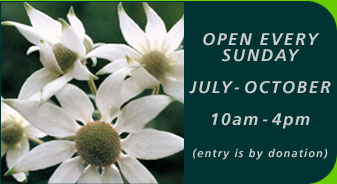

Newport Community Garden: Working Bee Second Sunday Of The Month
 Newport Community Gardens Inc. is a not for profit incorporated association. The garden is in Woolcott Reserve.
Newport Community Gardens Inc. is a not for profit incorporated association. The garden is in Woolcott Reserve.
ObjectivesLocal Northern Beaches residents creating sustainable gardens in public spacesStrengthening the local community, improving health and reconnecting with natureTo establish ecologically sustainable gardens for the production of vegetables, herbs, fruit and companion plants within Pittwater area To enjoy and forge friendships through shared gardening.Membership is open to all Community members willing to participate in establishing gardens and growing sustainable food.Subscription based paid membership.We meet at the garden between 9am – 12 noonNew members welcome
For enquiries contact newportcommunitygardenau@gmail.comFacebook: https://www.facebook.com/pg/newportcg Instagram: https://www.instagram.com/newportcgnsw
 Newport Community Gardens Inc. is a not for profit incorporated association. The garden is in Woolcott Reserve.
Newport Community Gardens Inc. is a not for profit incorporated association. The garden is in Woolcott Reserve.Pittwater Reserves
Annie Wyat Reserve - A W PictorialBarrenjoey Headland: Spring flowers Barrenjoey Headland after fire 4 Pines Brewery Newport will be providing up-cycled malt bags from the brewery to store the trash and keep it from our shores.
4 Pines Brewery Newport will be providing up-cycled malt bags from the brewery to store the trash and keep it from our shores.
Do you get a beer? Absolutely! 4 Pines will hand out tokens to participants which will be redeemable for a fresh cold beer back at Public House.

Stony Range Spring Fair
Sunday, September 9 at 9 AM - 4 PMStony Range Regional Botanic Garden810 Pittwater Road, Dee WhyHosted by Stony Range Regional Botanic Garden and Australian Plants Society Northern Beaches GroupFREE
Join in the fun at the Stony Range 'Bush Dreaming Spring Festival Sunday 9th September 2018Native plant sales and advice, displays and walks.
Children's activities, live native animals. Sculptures, photographs, live music.BBQ and coffee shop, home made cakes
10:30am is the official opening with Welcome to Country.
Cultivation advice from the members of Stony Range Botanic Garden & Australian Plants Society Northern Beaches Group.
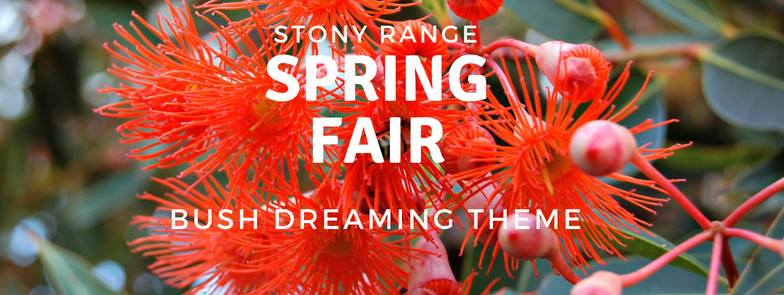

Mona Vale Garden Club's 47th Spring Flower Show
Saturday, 22 September 2018 - 10:00am to 3:00pmEveryone is invited to come to an exhibition of flowers, pot plants, vegetables, herbs and floral art.
There will also be sales of:- plants
- white elephant goods
- cakes
- refreshments
Entry: Adults $2, children free All profits will be donated to local charities.
Contact InformationMona Vale Garden Club IncName: PaulinePhone: 0418 221 907
LocationTed Blackwood HallCnr Jacksons & Boondah RoadsWarriewood NSW 2102

- plants
- white elephant goods
- cakes
- refreshments

Bee Keeping Talk At Warriewood
 Thursday, September 27, 20187:15pm – 9:00pmNelson Heather Centre4 Jacksons Rd.WarriewoodAt tonight's meeting hear about native and European honey bees and what PNB is doing as part of our bee program on the Northern Beaches of Sydney. Native bees are an important part of our biodiversity chain as well as a great source of nutritious honey.
Thursday, September 27, 20187:15pm – 9:00pmNelson Heather Centre4 Jacksons Rd.WarriewoodAt tonight's meeting hear about native and European honey bees and what PNB is doing as part of our bee program on the Northern Beaches of Sydney. Native bees are an important part of our biodiversity chain as well as a great source of nutritious honey.
Sydney has over 200 species of native bees many of which are solitary bees that require habitat in our gardens. You can also promote bees by providing a chemical free garden for them to pollinate. PNB has a program for selling native bees hives to supporters or program hives for free to community organisations.
More information on this and a lot more will be available on the night.
Paul Hoskinson is the bee team leader for PNB and also was a key driver in the setting up of the Northern Beaches Beekeepers Association.
‘If bees were to disappear for the globe, humankind would have only four years left to live’ Albert Einstein. Bees help us with pollination and are a vital part of our ecosystem. This will be a night not to be missed!
Doors open 7:15 pm at the Banksia Room, Nelson Heather Centre, 4 Jacksons Rd. Warriewood. All welcome, entry by donation. No need to book. There will also be a swap table - enjoy honey tasting + bring along plants, books, pots to swap.
Organic teas and coffee available, bring a plate of food to share also.
 Thursday, September 27, 2018
Thursday, September 27, 2018PNHA Newsletter 76
Read about wild life in the 'Burbs - How to identify local owl calls, the Wing Tag project and PNHA's latest campaign news.


Greening Your Home - Eco Retrofitting The Suburbs - Special Event

There’s no need for a ‘tree-change’ or ‘sea-change’ - Permaculture has made a shift to the suburbs
An extraordinary evening is planned for up to 400 people at Dee Why RSL on Tuesday 9th October at 7pm.
‘Our aim is to better equip residents of the Northern Beaches and beyond to live sustainably in the suburbs.’ said Michelle Sheather, Permaculture Northern Beaches Green Home team leader. ‘Over the last 18 months, PNB’s Green Home project has run dozens of workshops, meetings and courses on organic living, sustainable building, clean energy and wise use of resources.’
The culmination of the project, made possible by a community grant from Northern Beaches Council, is the October 9 special event on Eco Retrofitting the Suburbs. The panel of speakers for one night only, is David Holmgren, Jo Gillies and Costa Georgiadis. The talks will show how ordinary Australians can downshift and retrofit their houses, gardens, and lifestyles to be more sustainable and resilient.
David Holmgren, is one of the founders of permaculture, a leading ecological thinker, teacher, respected writer and speaker. He promotes permaculture as a realistic pathway to sustainability and a powerful way of life. David’s talk will introduce his best-selling new book RetroSuburbia - the downshifter’s guide to a resilient future (2018) that empowers us to make positive changes to everyday actions extending from the household out into neighbourhood and wider community activity.
Jo Gillies is founder and director of Archisoul Architects in Manly. She has worked with clients across the Northern Beaches to design sustainable houses that suit our climate, region and lifestyle. Jo will speak on aspects of sustainable house design including passive solar, energy options and which materials can be used to lessen our environmental footprint. Design efficiencies for existing buildings and how do an eco-friendly retrofit will be discussed. Jo will show that good design principals can create a sense of community and soul for the household.
Costa Georgiadis has been the host of Gardening Australia, the ABC's iconic gardening show, since 2012. He is a landscape architect who has a passion for plants and people. For Costa, soil and water are central to absolutely everything. Costa has written the forward for the book ‘Don’t be afraid to throw open RetroSuburbia on any page at any time and dive into the possible …’ says Costa.
Come along to be part of this great evening. Bookings are essential www.permaculturenorthernbeaches.org.auA donation of $5 is recommended as entry fee.
The talk night will be during the school holidays, older children and teenagers are most welcome with an adult. A raffle with prizes of eco products and a copy of David’s book will be held on the night.
Permaculture is a design system for sustainable living in your home, garden and lifestyle. It originated in Tasmania in the 1970s with co-founders Bill Mollison and David Holmgren and is now practiced worldwide. The word is the merging of permanent/sustainable and culture.

Curious Kids: What Sea Creature Can Attack And Win Over A Blue Whale?
August 21, 2018
authors;Wally FranklinResearcher and co-director of the The Oceania Project, Southern Cross UniversityTrish FranklinResearcher and co-director of The Oceania Project , Southern Cross University
This is an article from Curious Kids, a series for children. The Conversation is asking kids to send in questions they’d like an expert to answer. All questions are welcome – serious, weird or wacky! You might also like the podcast Imagine This, a co-production between ABC KIDS listen and The Conversation, based on Curious Kids.
What sea creature can attack and win over a blue whale? – Drake, age 7, Sydney.
Hi Drake. That is an interesting question.
As you probably know, blue whales are the largest creatures to have ever lived on Earth – bigger than any dinosaur. They can grow up to 30 metres in length and weigh over 150 tonnes. This is very, very BIG. To give you an idea of how big a blue whale is, it’s the size of a Boeing 737 plane! Because of their size, power and speed, adult blue whales have virtually no natural ocean predators.
The only sea creature known to attack blue whales is the orca whale (scientific name: Orcinus orca) also known as the “killer whale”. They have been known to work in groups to attack blue whales.
However, there are very few reports of orcas actually killing blue whales. We know that orca whales interact with them because many blue whales carry scars from the teeth of orcas. But blue whales probably see orcas as more of a pest than a predator.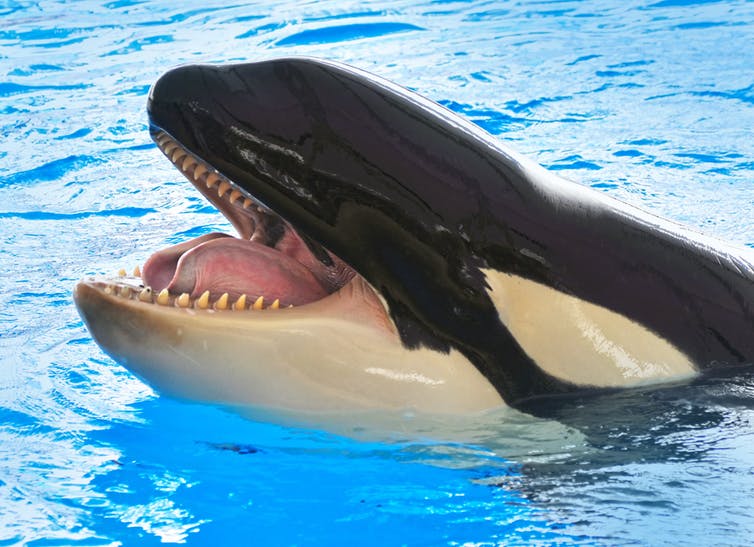
Orcas have sharp teeth.

Blue whales can grow 30 metres in length and weigh over 150 tonnes. Kurzon/Wikimedia Commons, CC BY-SA
The human threatA much more serious problem for blue whales is humans. Humans have caused a lot of trouble for blue whales over the years.
One big problem is what we call “ship strikes”. This is when large ships collide with blue whales causing dreadful wounds and, in many cases, death.
Blue whales migrate freely across all the great oceans of the world to breed. They travel each year to the Antarctic in search of food. Global warming is a major future threat to their way of life. This is because rising sea temperatures and ocean acidification (which are caused by climate change) are likely to cause severe disruption to the production of their main food source, the very small crustacean we call “krill”.
Blue whales were the target of commercial whalers, mainly in Antarctica, between 1900 and the 1970s. During that time, over 330,000 blue whales were killed.
Fortunately - and only just in time - the International Whaling Commission banned commercial whaling in 1966. Blue whales are now a protected species and are recovering from the brink of extinction. People on whale watching trips at various locations around the world can see them, if they are lucky. The risk of whaling still exists in several countries, including Japan, Iceland and Norway. Many people in these countries are seeking to return to commercial whaling. Recently, whalers in Iceland killed a hybrid blue whale.
Blue whales can talkOne of the most interesting things about blue whales is that they use very low frequency sounds to communicate. Through this they can talk to each other over great distances. The low frequency sounds can pass through the earth, so it’s possible to record their songs and sounds from anywhere in the world.
In the 1960s, an American scientist called Chris Clark got permission to use the USA’s submarine listening system across the Atlantic Ocean to listen to blue whales. One day, he heard a blue whale calling from the far northeast Atlantic Ocean and realised another whale many thousands of miles away in the southwest Atlantic Ocean was answering it. Through their calls, he tracked them over the next few weeks moving towards each other. The two blue whales met and spent time together in the middle of the Atlantic. Then they separated and went on their way!
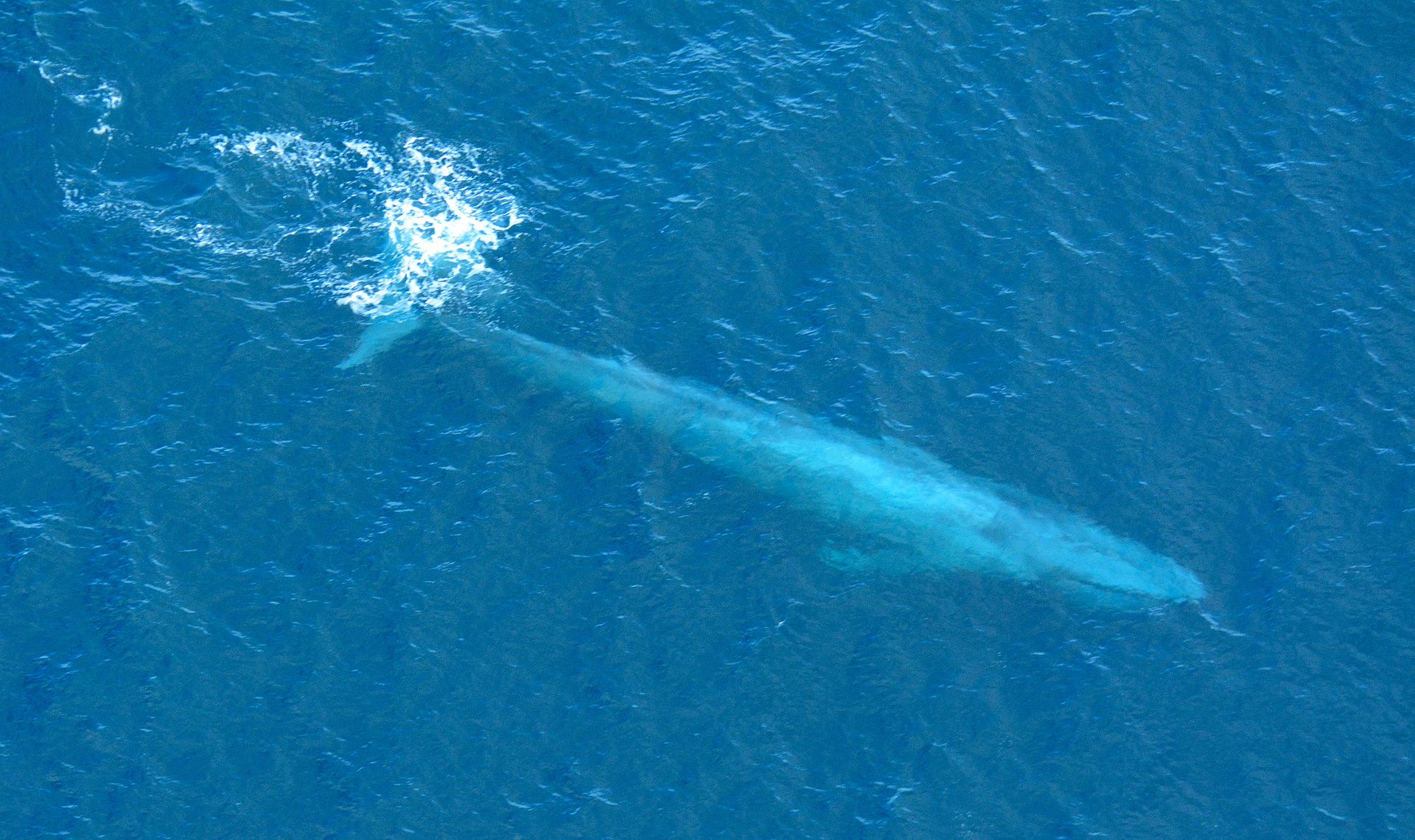
Large Blue Whale Off Southern California Coast. Photo by D Ramey LoganIt is important for all who are interested in the conservation and protection of these amazing creatures to remain vigilant and involved in making sure that they remain safe. Whales are part of the international heritage of all people of the Earth.
Hello, curious kids! Have you got a question you’d like an expert to answer? Ask an adult to send your question to us. They can: Email your question to curiouskids@theconversation.edu.au



White-Winged Choughs Foraging – Capertee Valley
Published August 23, 2018 by BIBY TVThese White-winged Choughs (Corcorax melanorhamphos) were filmed in July and August 2018 in the Capertee Valley, NSW. The exact location is a private property that has a mix of open forest (on higher slopes), woodland and larger open spaces in the form of grassland with pockets of shrubbery (e.g. acacias). It used to be part of a working farm but underwent extensive habitat restoration over a couple of decades. Visit https://youtu.be/a6qM_bl-AnA for more information on the site. All of the footage came from the general area shown in the first photo. The third photo was taken in May.
We have also seen these birds elsewhere in the valley, including paddocks. In all cases though they are never far from trees. While White-winged Choughs spend much of their day foraging on the ground, they need trees for protection (when disturbed), resting, roosting, nesting and for leaf litter (which increases the number of invertebrates). As you can see in this video, they also probe and dig into topsoil. They are quite systematic in their foraging and work in groups with a spread-out formation. (Hence the camera follows just one bird.) On this particular site we have seen 5 – 10 choughs at a time. The typical size of a group or clan is around 5 – 20. (Sometimes only a couple of birds are visible, especially when they are hidden in the trees.)
Remembering The Dunbar
August 20, 2018: NSW Heritage Minister, The Hon. Gabrielle Upton
A minutes silence was held yesterday on the cliffs above Dunbar Head to commemorate the greatest peacetime shipwreck disaster in the state’s history.
“There was one survivor of the 122 people on board when the Dunbar ran aground at the foot of the sea cliffs above Watson’s Bay on this day in 1857,” Heritage Minister Gabrielle Upton said.
“The story of the sinking of the Dunbar, packed with immigrants perhaps coming to seek their fortunes in the gold rush so close to their destination is one of the saddest for its sheer scale.
“Instead of welcoming their loved ones in Sydney Cove, Sydney siders watched from the cliffs in horror as bodies were pounded on the rocks below.
“Miraculously one lone survivor was tossed onto a rock shelf at the base of the cliffs at Gap Bluff and clung there for two days until rescuers were able to reach him,” Minister Upton said.
“Today we have only a few reminders of the tragedy, including the wreck itself, an anchor memorial, historic rock engravings on the cliffs above the wreck site and victims’ burial plot at St Stephens Church and Cemetery Newtown, all of which are protected by listing on the State Heritage Register.
“Preserving, commemorating and researching historic events like this reminds us of our past and shapes our understanding of our heritage.
“That’s why the Office of Environment and Heritage is undertaking more research on the wreck site, with the assistance of not-for-profit group Silentworld Foundation.
“We will be undertaking the first side-scan sonar survey of the wreck, which lies some 11 metres underwater, to map the site and this will add to our understanding of its archaeological extent.
“Further works at the site will see recording undertaken of etchings left on the sandstone rocks above the wreck by the rescuers in 1857.
“These etchings act as an historic graffiti memorial and recording them will assist in ongoing management,” Minister Upton said.
Sweeter Dreams In A Peaceful Mind
August 24, 2018: University of Turku
It has long been assumed that the content of dreams can tell us something about the person's well-being. However, so far dream researchers have mostly studied the dreams of people suffering from various disorders and we know very little about the positive side of well-being: do happier people have happier dreams? Well-being researchers, on the other hand, have specifically studied happiness, but have neglected an important aspect of well-being -- peace of mind.
"We wanted to address these important gaps in both dream and well-being research and to study how dream emotions are related to not only different aspects of waking ill-being, but also to different aspects of waking well-being, including peace of mind. In fact, this is the first study to look at how peace of mind relates to dream content," says Pilleriin Sikka, Doctoral Candidate in Psychology at the University of Turku and Lecturer in Cognitive Neuroscience at the University of Skövde, and lead author of the article published in the Nature group journal Scientific Reports.
"Peace of mind is a state of inner peace and harmony, a more complex and durable state of well-being traditionally associated with happiness in the Eastern cultures," Sikka continues.
"Even though it has rarely been directly measured in studies of well-being, in several philosophical traditions and spiritual approaches, peace of mind has always been regarded as central to human flourishing," adds co-author Antti Revonsuo, Professor of Psychology at the University of Turku and Professor of Cognitive Neuroscience at the University of Skövde.
The researchers asked healthy participants to fill in a questionnaire that measured their waking ill-being and well-being. Then, during the following three weeks the participants kept a daily dream diary in which, every morning upon awakening, they reported all their dreams and rated the emotions they experienced in those dreams. Results showed that individuals with higher levels of peace of mind reported more positive dream emotions, whereas those with higher levels of anxiety reported more negative dream emotions.
These findings show that if we want to understand how dream content is related to waking well-being, it is not enough to measure only the symptoms of mental ill-being but we should measure well-being in its own right. Surprisingly, those aspects that are typically considered and measured as 'well-being' were not related to dream content. So there seems to be something unique about peace of mind and anxiety, Sikka explains.
The researchers propose that individuals with higher levels of peace of mind may be better able to regulate their emotions not only in the waking state but also during dreaming, whereas the opposite may be true for those with higher levels of anxiety.
In future studies we should explore whether better emotion regulation capacity, and self-control in general, is indeed something that characterises people with higher levels of peace of mind, and whether improving such skills can also lead to more peace of mind, Sikka concludes.
Pilleriin Sikka, Henri Pesonen, Antti Revonsuo. Peace of mind and anxiety in the waking state are related to the affective content of dreams. Scientific Reports, 2018; 8 (1) DOI: 10.1038/s41598-018-30721-1
Sharp Increase In Falls In Women During Midlife
August 21, 2018: Trinity College Dublin
Falls are not just a problem of advanced age, according to researchers in Trinity College Dublin, who have identified a sharp increase in falls after the age of 40, particularly in women.
The research, which drew on data from TILDA (the Irish Longitudinal Study on Ageing) as well as data from similar studies in Australia, Great Britain and the Netherlands, found that for women the prevalence of falls increases from the age of 40 on -- 9% in 40-44 year olds, 19% in 45-49 year olds, 21% in 50-54 year olds, 27% in 55-59 year olds and 30% in 60-64 year olds.
The findings indicate that middle-age may be a critical life stage for interventions designed to prevent falls, according to the authors. The study incorporated the data from 19,207 men and women aged between 40 and 64 years. It has been recently published in the international journal PLOS ONE.
With one in three older adults falling at least once per year, rising to one in two adults over 80 years, falls are a major health challenge. Serious health consequences include fractures, head injuries, reduced social participation, increased risk of nursing home admittance, decline in independence and subsequently increased need for care. Health experts estimate that the costs for falls in Ireland are projected to be over €1 billion by 2020 . Dr Geeske Peeters, Atlantic Fellow for Equity in Brain Health at the Global Brain Health Institute at Trinity, lead author on the paper commented: "Researchers and doctors have always assumed that falls are a problem that only affects people above the age of 65. This study shows that the prevalence of falls is already quite high from the age of 50. In fact, our research shows that there is a sharp increase in the prevalence of falls in women during midlife. This occurs at a time that we also see an increase in the prevalence of common risk factors for falls, such as balance problems, diabetes and arthritis."
Recommended strategies for the prevention of falls in older adults are insufficiently effective, according to the authors. Previous research shows that, in theory, exercise may reduce the rate of falls by up to 32% and assessment and treatment of risk factors may reduce the rate of falls by up to 24%. However, hospital injury records show that the number of injuries from falls which require medical care continue to rise.
Dr Peeters continued: "Current prevention strategies basically wait until people have developed risk factors and then try to make them go away. It may be better and more effective to prevent the risk factors, or to detect them at an early stage to reduce their consequences, particularly falls. We are now working with our research colleagues in the Netherlands, Australia and the UK to investigate whether there is scope to start prevention strategies before the age of 65 years."
Professor Rose Anne Kenny, senior author on the paper and director of TILDA and of the Falls Unit at St James Hospital, commented: "This work emphasises the importance of early prevention strategies. While falls can cause serious injury and result in disability, they also create fear of further falls. This is a well known phenomenon and from TILDA research we know it is present in one in four people over 50. People who have a fear of falling or have had a fall are most at risk of falls and should be targeted for strength and balance programmes and medication reviews -- both strategies significantly reduce falls."
The timing of the increases in falls coincides with the onset of the menopause, decline in balance performance, and increase in the presence of vertigo and fainting, all of which will benefit from the above falls prevention strategies.
Dr Peeters concluded: "A better understanding of the factors that drive this increase in fall risk in middle age may be the key to effective prevention interventions earlier in life with potential benefits into older age. Further research should help us design the most appropriate strategies to prevent falls at this critical juncture in a person's life."
Geeske Peeters, Natasja M. van Schoor, Rachel Cooper, Leigh Tooth, Rose Anne Kenny. Should prevention of falls start earlier? Co-ordinated analyses of harmonised data on falls in middle-aged adults across four population-based cohort studies. PLOS ONE, 2018; 13 (8): e0201989 DOI: 10.1371/journal.pone.0201989
Newly Identified Structure In Lymph Nodes Was 'Hiding In Plain Sight'
August 22, 2018: Garvan Institute of Medical Research
For the first time in decades, researchers have identified a new 'micro-organ' within the immune system -- and they say it's an important step towards understanding how to make better vaccines.
In a study published this week in Nature Communications, scientists at Australia's Garvan Institute of Medical Research have identified where the immune system 'remembers' past infections and vaccinations -- and where immune cells gather to mount a rapid response against an infection the body has seen before.
The structure was only discovered when the researchers 'made movies' of the immune system in action, using sophisticated high resolution 3D microscopy in living animals. Jam-packed with immune cells of many kinds, the structure is strategically positioned to detect infection early, making it a one-stop shop for fighting a 'remembered' infection -- fast.
We have known for millennia that people exposed to an infection are often protected from getting the same infection again -- ever since the Plague of Athens in 430 BC, where plague survivors were noted to have developed immunity against reinfection. Yet, major questions remain about how the body can fight back fast when it encounters an infection that it has been previously exposed to (through a vaccine or through an earlier infection).
A new structure that appears when it's needed
The researchers reveal the existence of thin, flattened structures extending over the surface of lymph nodes in mice. These dynamic structures are not always present: instead, they appear only when needed to fight an infection against which the animal has previously been exposed.
Crucially, researchers also saw the structures -- which they have named SPFs (or 'subcapsular proliferative foci') -- inside sections of lymph nodes from patients, suggesting that they help fight reinfection in people as well as in mice.
Using sophisticated 'two-photon' in vivo microscopy, the researchers could see that several classes of immune cells gathered together in SPFs. Memory B cells, which carry information about how best to attack the infection, clustered there. So did other cell types that act as helpers.
Importantly, the researchers could also see that memory B cells were changing into infection-fighting plasma cells. This is a key step in the fight against infection, because plasma cells make antibodies to recognise and fend off the invader and protect the body from disease.
"It was exciting to see the memory B cells being activated and clustering in this new structure that had never been seen before," says Garvan's Dr Imogen Moran, the first author on the new study. "We could see them moving around, interacting with all these other immune cells and turning into plasma cells before our eyes."
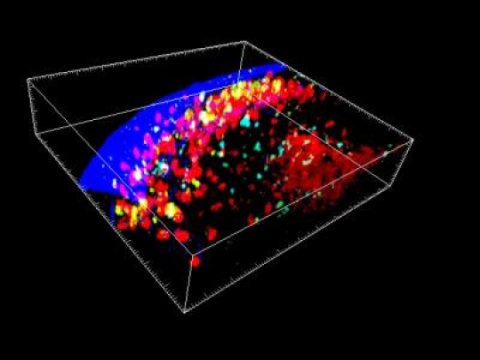
Immune cells (pink and green) gathering at the subcapsular proliferative locus (SPF), a newly discovered immune system structure that appears in the lymph node. Blue = surface of the lymph node. Credit: Imogen Moran & Tri Phan/Garvan Institute
A need for speed
A/Prof Tri Phan (who led the research) says the SPF structures are perfectly placed to fight infection fast -- so they can stop disease in its tracks before it takes hold.
"When you're fighting bacteria that can double in number every 20 to 30 minutes, every moment matters. To put it bluntly, if your immune system takes too long to assemble the tools to fight the infection, you die," he says.
"This is why vaccines are so important. Vaccination trains the immune system, so that it can make antibodies very rapidly when an infection reappears. Until now we didn't know how and where this happened.
"Now, we've shown that memory B cells rapidly turn into large numbers of plasma cells in the SPF. The SPF is located strategically where bacteria would re-enter the body and it has all the ingredients assembled in one place to make antibodies -- so it's remarkably well engineered to fight reinfection fast."
Hiding in plain sight
The researchers say no one had seen the structures before because traditional microscopy approaches look at thin 2D sections of tissue that been chemically 'fixed' to provide a snapshot in time. The SPF is thin, and it comes and goes: these are both attributes that make it hard to detect using a conventional approach.
"It was only when we did two-photon microscopy -- which lets us look in three dimensions at immune cells moving in a living animal -- that we were able to see these SPF structures forming," says Dr Moran.
"So this is a structure that's been there all along, but no one's actually seen it yet, because they haven't had the right tools. It's a remarkable reminder that there are still mysteries hidden within the body -- even though we scientists have been looking at the body's tissues through the microscope for over 300 years," says A/Prof Phan.
Hope for better vaccines
A/Prof Phan says the new discovery is an important step towards understanding how to make better vaccines.
"Up until now we have focussed on making vaccines that can generate memory B cells," he says. "Our finding of this new structure suggests that we should now also focus on understanding how those memory B cells are reactivated to make plasma cells, so that we can make this process more efficient."
Support for this work
The study was made possible by generous support from the NHMRC, the Garvan Research Foundation, and Mr and Mrs Peter and Val Duncan.
Imogen Moran, Akira Nguyen, Weng Hua Khoo, Danyal Butt, Katherine Bourne, Clara Young, Jana R. Hermes, Maté Biro, Gary Gracie, Cindy S. Ma, C. Mee Ling Munier, Fabio Luciani, John Zaunders, Andrew Parker, Anthony D. Kelleher, Stuart G. Tangye, Peter I. Croucher, Robert Brink, Mark N. Read, Tri Giang Phan. Memory B cells are reactivated in subcapsular proliferative foci of lymph nodes. Nature Communications, 2018; 9 (1) DOI: 10.1038/s41467-018-05772-7
Quantum Leap For Einstein's Equivalence Principle
August 21, 2018: University of Queensland
How Einstein's equivalence principle extends to the quantum world has been puzzling physicists for decades, but a team including a University of Queensland researcher has found the key to this question.
UQ physicist, Dr Magdalena Zych from the ARC Centre of Excellence for Engineered Quantum Systems, and the University of Vienna's Professor Caslav Brukner have been working to discover if quantum objects interact with gravity only through curved space-time.
"Einstein's equivalence principle contends that the total inertial and gravitational mass of any objects are equivalent, meaning all bodies fall in the same way when subject to gravity," Dr Zych said.
"Physicists have been debating whether the principle applies to quantum particles, so to translate it to the quantum world we needed to find out how quantum particles interact with gravity.
"We realised that to do this we had to look at the mass."
Mass is dynamic quantity and can have different values, and in quantum physics, mass of a particle can be in a quantum 'superposition' of two different values.
In a state unique to quantum physics, energy and mass can exist in a 'quantum superposition' -- as if they consisted of two different values 'at the same time'.
"We realised that we had to look how particles in such quantum states of the mass behave in order to understand how a quantum particle sees gravity in general," she said.
"Our research found that for quantum particles in quantum superpositions of different masses, the principle implies additional restrictions that are not present for classical particles -- this hadn't been discovered before.''
"It means that previous studies that attempted to translate the principle to quantum physics were incomplete because they focused on trajectories of the particles but neglected the mass."
The study opens a door for new experiments that are necessary to test if quantum particles obey the additional restrictions that have been found.
Magdalena Zych, Časlav Brukner. Quantum formulation of the Einstein equivalence principle. Nature Physics, 2018; DOI: 10.1038/s41567-018-0197-6

Artist's impression of quantum formulation. Credit: Australian Research Council Centre of Excellence for Engineered Quantum Systems (EQUS)
Disclaimer: These articles are not intended to provide medical advice, diagnosis or treatment. Views expressed here do not necessarily reflect those of Pittwater Online News or its staff.